New energy vehicle power battery system development involves materials, chemistry, mechanics, thermodynamics, heat transfer, fluid mechanics, electricity, systems and control. Its key technologies include battery assembly technology, thermal management technology, power management technology and safety. Management technology, etc. The vehicle power battery system technology has become the bottleneck of the popularization of electric vehicles. It needs to explore and break through many aspects such as material development, battery design, manufacturing, system integration, and business models.
This article refers to the address: http://

1. Classification of new energy vehicle power batteries
New energy vehicle power batteries can be divided into two categories: batteries and fuel cells. The batteries are used in pure electric vehicles (EV), hybrid electric vehicles (HEV) and plug-in hybrid electric vehicles (PHEV); fuel cells are dedicated to fuels. Battery car (FCV).
1.1 battery
The battery is the only power source for the drive system in pure electric vehicles, mainly nickel-cadmium, nickel-metal hydride and lithium-ion batteries. At present, lithium-ion batteries are in a high-speed development stage, and lithium-ion batteries are used in new energy vehicles such as the Nissan Leaf, the Toyota Prius plug-in, the Tesla Model S, the Volkswagen Volt, the Ford Focus EV, and the BMW i3. In addition, lithium resources are more abundant, and the price is not expensive. It can be said that lithium-ion batteries are the most promising power batteries in the battery. The performance comparison of the four types of batteries is shown in Figure 1.
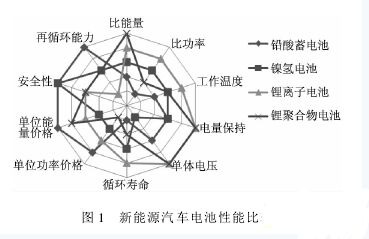
1.2 fuel cell
A fuel cell is a device in which a fuel and an oxidant react directly through their electrodes to convert their chemical energy into electrical energy. The fuel cell does not need to be charged, and has the advantages of high specific energy, long service life, low maintenance workload, and continuous high-power supply. In addition, fuel cell vehicles can achieve the same driving range as fuel vehicles.
Depending on the electrolyte, fuel cells can be classified into alkaline fuel cells, phosphoric acid fuel cells, proton exchange membrane fuel cells, molten carbonate fuel cells, and solid oxide fuel cells. At present, proton exchange membrane fuel cells are widely used in fuel cell vehicles, and are highly competitive battery types in the field of new energy vehicle power batteries.
2. Overview of new energy power battery industry technology
Because different types of new energy vehicles, the use of vehicle power batteries has a big difference, so there is a big difference in their performance requirements. HEV has a gasoline engine as a power source, with more emphasis on acceleration performance and climbing ability. Therefore, it pays more attention to the specific power of the battery (requires up to 800-1200 W/kg); PHEV and EV are completely powered by batteries, and more emphasis on the continuation after charging. Driving ability, so pay more attention to the specific energy of the battery (required to reach 100-160Wh/kg) (see Table 1).
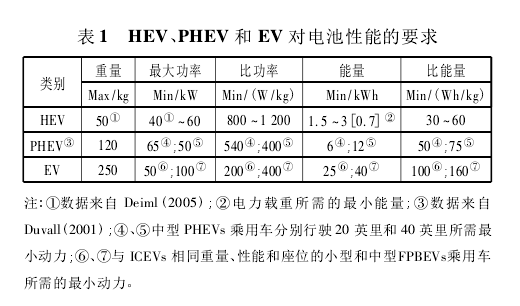
Due to the significant differences in performance, materials, cost, etc., the use prospects of different types of power batteries are different. At present, the most mature technology is nickel-hydrogen battery, but the most successful commercialization is lithium-ion battery, and fuel cell is widely regarded as a long-term target.
Currently, the fastest growing among the power battery categories is lithium batteries. Since 2012, the lithium battery industry has maintained rapid growth and accelerated the replacement of traditional batteries. The industry expects that the growth rate of lithium batteries will still maintain an average annual rate of nearly 25% and the cost will continue to decline.
In recent years, fuel cell technology has also made significant progress. Toyota and Hyundai's fuel cell vehicles are also on the eve of the market. In China, SAIC's fuel cell vehicles are in a leading position. This model was used as a VIP reception vehicle during the 2010 Shanghai World Expo. In 2011, at the 11th Bibendum Challenge in Berlin, Germany, SAIC ranked third in the fuel cell vehicle rally, second only to Toyota and Audi.
At present, the technical status of fuel cells at home and abroad is shown in Table 2.
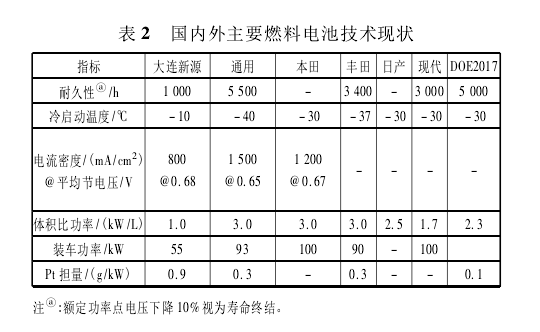
As of December 2014, the fuel cell vehicles of major auto companies are still in the state of trial verification. Only one fuel cell battery product of Toyota FCV is announced for mass production. The following is an example of the development of the industrialization status of lithium-ion batteries that are developing rapidly in the market.
2.1 New energy vehicle power battery mainstream: Lithium Ion Battery
In the existing new energy vehicle power battery, the production cost of the lithium ion battery is relatively low, and the repeated charging and utilization is very convenient, and has a higher cost advantage than other portable energy sources. Therefore, these types of batteries have become the most popular power source (see Table 3).
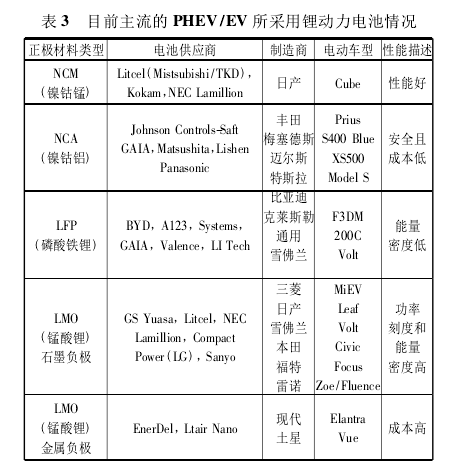
2.2 Status of lithium ion power battery industry
At present, the main producers of lithium-ion batteries are Japan, South Korea and China. Among them, Japan and South Korea account for nearly 70% of the global power battery market, mainly because of its clear division of labor and administrative barriers. The system integration capability of OEMs and system integrators is much higher than that of Chinese pure electric vehicle manufacturers.
In recent years, the proportion of lithium-ion batteries used in new energy vehicles in China has been increasing, and the lithium battery market has a broad space. According to the new energy vehicle development planning route, the sales volume of domestic pure electric vehicles reached 500,000 in 2015, and hybrid power accounted for 30% of all vehicle sales. In 2020, pure electric vehicles will exceed 5 million, and energy-saving vehicles represented by hybrid power Reached 75% of all car sales.
2.3 lithium ion power battery technology development trend
The lithium ion power battery is mainly composed of a positive electrode material, a negative electrode material, an electrolyte and a battery separator (see Table 4).
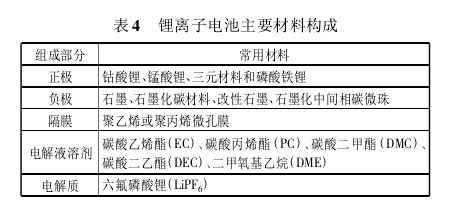
Lithium battery cathode materials currently in use and development mainly include lithium cobaltate, lithium nickel cobaltate, nickel manganese cobalt ternary materials, spinel lithium manganate, olivine lithium iron phosphate and the like. According to the classification of cathode materials, there are three main routes for developing lithium-ion power batteries: modified lithium manganate, ternary materials and lithium iron phosphate. At present, lithium cobaltate is still the main force of cathode materials in small lithium batteries, mainly used in traditional 3C (Computer, Communication and Consumer E-lectronic) fields; ternary materials and lithium manganate are mainly used in electric tools, electric bicycles and electric vehicles. In other fields, in Japan and South Korea, its technology as a power battery is relatively mature; lithium iron phosphate is mainly used in the domestic power battery field, and is also used in the fields of base station and data center energy storage, household energy storage, wind and photovoltaic energy storage.
The development of lithium battery product technology will show the following trends.
Portable Energy Storage,energy storage companies,energy storage examples,potential energy storage,portable energy source
Langrui Energy (Shenzhen) Co.,Ltd , https://www.langruibattery.com